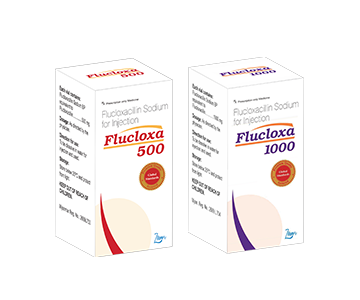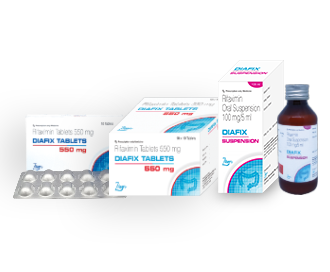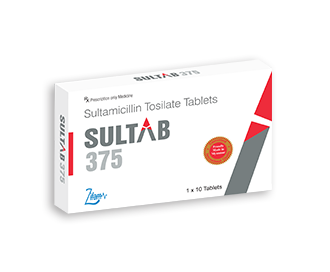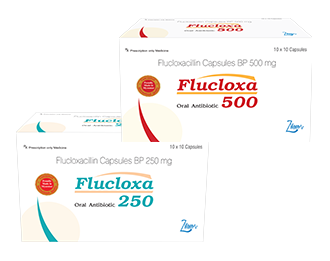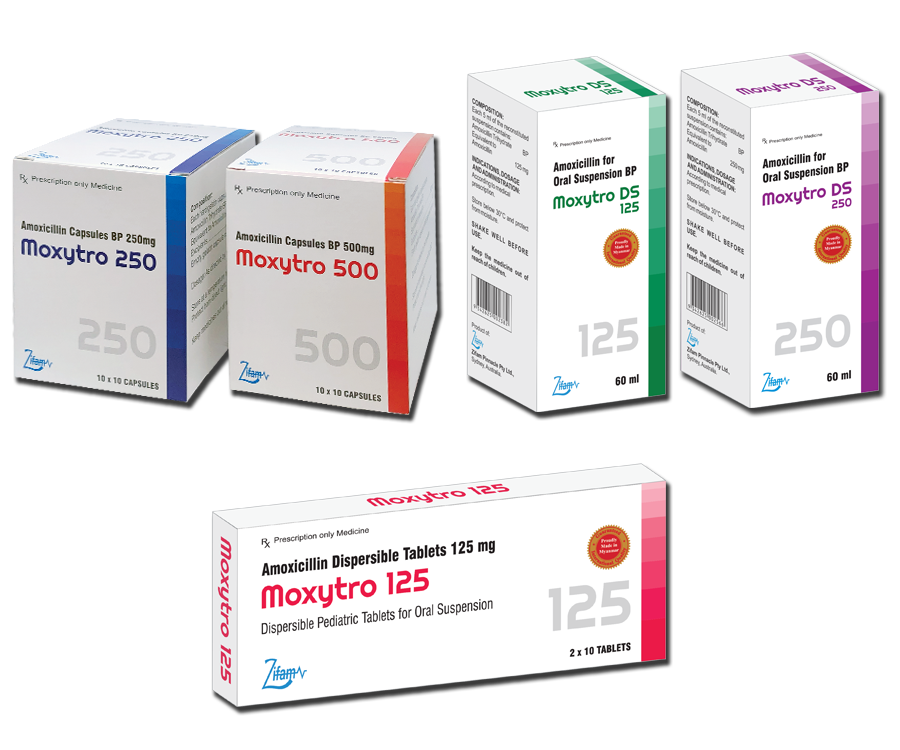Zisuva 600/1200 Injection
- ENG
- မြန်မာ
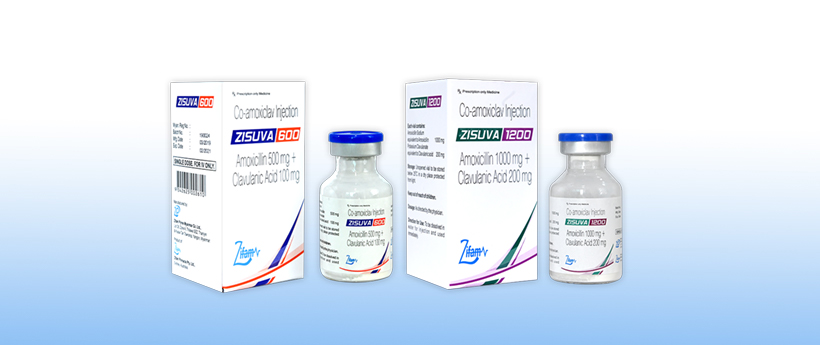
Co-amoxiclav Injection
COMPOSITION
Each vial of ZISUVA 600 contains
Amoxicillin Sodium equivalent to Amoxicillin …………………………500 mg
Potassium Clavulanate equivalent to Clavulanic acid………………..100 mg
Each vial of ZISUVA 1200 contains
Amoxicillin Sodium equivalent to Amoxicillin………………………………1000 mg
Potassium Clavulanate equivalent to Clavulanic acid ……………………….200 mg
Therapeutic Indications
ZISUVA Injection is indicated for the treatment of the following infections in adults and children;
Severe infections of the ear, nose and throat (such as mastoiditis, peritonsillar infections, epiglottitis, and sinusitis when accompanied by severe systemic signs and symptoms), Acute exacerbations of chronic bronchitis (adequately diagnosed), Community acquired pneumonia, Cystitis, Pyelonephritis, Skin and soft tissue infections in particular cellulitis, animal bites, severe dental abscess with spreading cellulitis, Bone and joint infections, in particular osteomyelitis, Intra-abdominal infections,
Female genital infections.
Prophylaxis against infections associated with major surgical procedures in adults, such as mose involving the Gastrointestinal tract, Pelvic cavily, Head and neck, Biliary tract surgery.
METHOD OF ADMINISTRATION
ZISUVA Injection is for intravenous use.
ZISUVA Injection may be administered either by Slow intravenous injection over a period of 3 to 4 min directly into a vein or via a drip tube or by infusion over 30 to 40 min. ZISUVA Injection is not suitable for intramuscular administration.
Children aged less than 3 months should be administered ZISUVA Injection by infusion only.
Treatment with ZISUVA Injection may be initiated by the use of an intravenous preparation and completed with an appropriate oral presentation as considered appropriate for the individual patient.
CONTRAINDICATIONS
Hypersensitivity to the active substances, to any of the peniclins orto any ofthe excipients.
History of a severe immediate hypersensitivity reaction (e.g.anaphylaxis) to another beta-lactam agent (eg, a cephalosporin, carbapenem or monobactam): History of jaundice hepatic impairment due to amoxicillin clavulanic acid.
SPECIAL WARNINGS AND PRECAUTIONS FOR USE
Before initiating therapy with amoxicillin / clavulanic acid, careful enquiry should be made concerning previous hypersensitivity reactions to penicillins, cephalosporins, or other beta-lactam agents.
Convulsions may occur in patients with impaired renal function or in those receiving high doses.
Amoxicillin / clavulanic acid should be avoided if infectious mononucleosis is suspected since the occurrence of a morbilliform rash has been associated with this condition following the use of amoxicillin. Concomitant use of allopurinol during treatment with amoxicillin can increase the likelihood of allergic skin reactions
INTERACTION WITH OTHER MEDICINAL PRODUCTS
Oral anticoagulants
Oral anticoagulants and penicillin antibiotics have been widely used in practice without reports of interaction. However, there are cases of increased international normalised ratio in patients maintained on acenocoumarol or warfarin and prescribed a course of amoxicillin. If co-administration is necessary, the prothrombin time or international normalized ratio should be carefully monitored with the addition or withdrawal of amoxicillin. Moreover, adjustments in the dose of oral anticoagulants may be necessary.
Methotrexate
Penicillin may reduce the excretion of methotrexate causing a potential increase in toxicity.
Probenecid
Concomitant use of probenecid is not recommended. Probenecid decreases the renal tubular secretion of amoxicillin. Concomitant use of probenecid may result in increased and prolonged blood levels of amoxicillin but not of clavulanic acid.
Mycophenolate motetil
In patients receiving mycophenolate mofetil, reduction in pre-dose concentration of the active metabolite mycophenolic acid (MPA) of approximately 50% has been reported following commencement of oral amoxicillin plus clavulanic acid. The change in pre-dose level may not accurately represent changes in overall MPA exposure. Therefore, a change in the dose of mycophenolate mofetil should not normally be necessary in the absence of clinical evidence of graft dysfunction. However, close clinical monitoring should be performed during the combination and shortly after antibiotic treatment.
FERTILITY, PREGNANCY AND LACTATION
Pregnancy
Limited data on the use of amoxicillin/ clavulanic acid during pregnancy in humans do not indicate an increased risk of congenital malformations.
Use should be avoided during pregnancy, unless considered essential by the physician.
Breastfeeding
Both substances are excreted into breast milk Consequently, diarrhea and fungus infection of the mucous membranes are possible in the breastfed infant, so that breast-feeding might have to be discontinued. The possibility of sensitization should be taken into account. Amoxicillin / clavulanic acid should only be used during breastfeeding after benefit / risk assessment by the physician in charge.
UNDESIRABLE EFFECTS
The most commonly reported adverse drug reactions (ADRs) are diarrhea, nausea and vomiting.
OVERDOSE
Gastrointestinal symptoms and disturbance of the fluid and electrolyte balances may be evident.
Amoxicillin crystalluria, in some cases leading to renal failure, has been observed.
Convulsions may occur in patients with impaired renal function or in those receiving high doses.
Amoxicillin has been reported to precipitate in bladder catheters, predominantly after intravenous administration of large doses. A regular check of patency should be maintained.
Treatment of intoxication
Gastrointestinal symptoms may be treated symptomatically, with attention to the water / electrolyte balance.
Amoxicillin/ clavulanic acid can be removed from the circulation by hemodialysis.
Dr. Shine Khant Ye Yint
Product Executive
95 Residence, Kyaik Waing Pagoda Road,
ph no – 0943051114
Office – 09261772689/ 019669344/ 019669345/
019669346/ 019669347/ 019669348
Website – www.zifammyanmar.com
Facebook- www.facebook.com/
SHELF LIFE
Powder in vials: 24 Months
STORAGE
Store below 25°C.
Protect from light and moisture.
Keep medicine out of reach of children.
PRESENTATION
Each vial packed in a carton along with pack insert.
SPECIAL PRECAUTIONS FOR DISPOSAL
Single dose for IV use only. Discard any unused solution.
The reconstitution / dilution is to be made under aseptic conditions. The solution is to be inspected visually for particulate matter and discoloration prior to administration. The solution should only be used if the solution is clear and free from particles.
Any unused medicinal product or waste material should be disposed of in accordance with local requirements.
Updated on 9.2.2024







